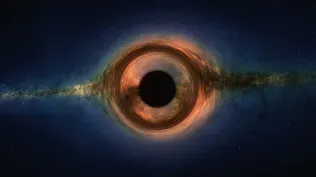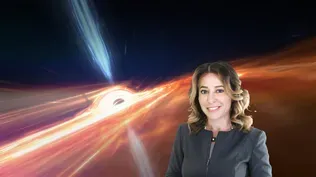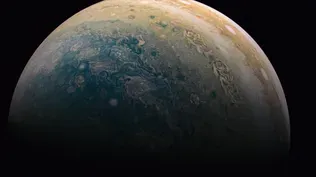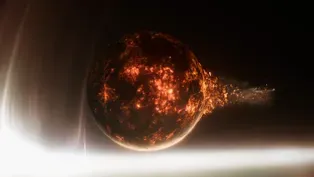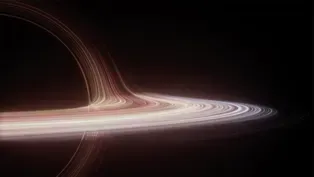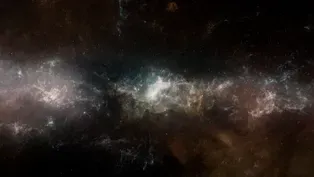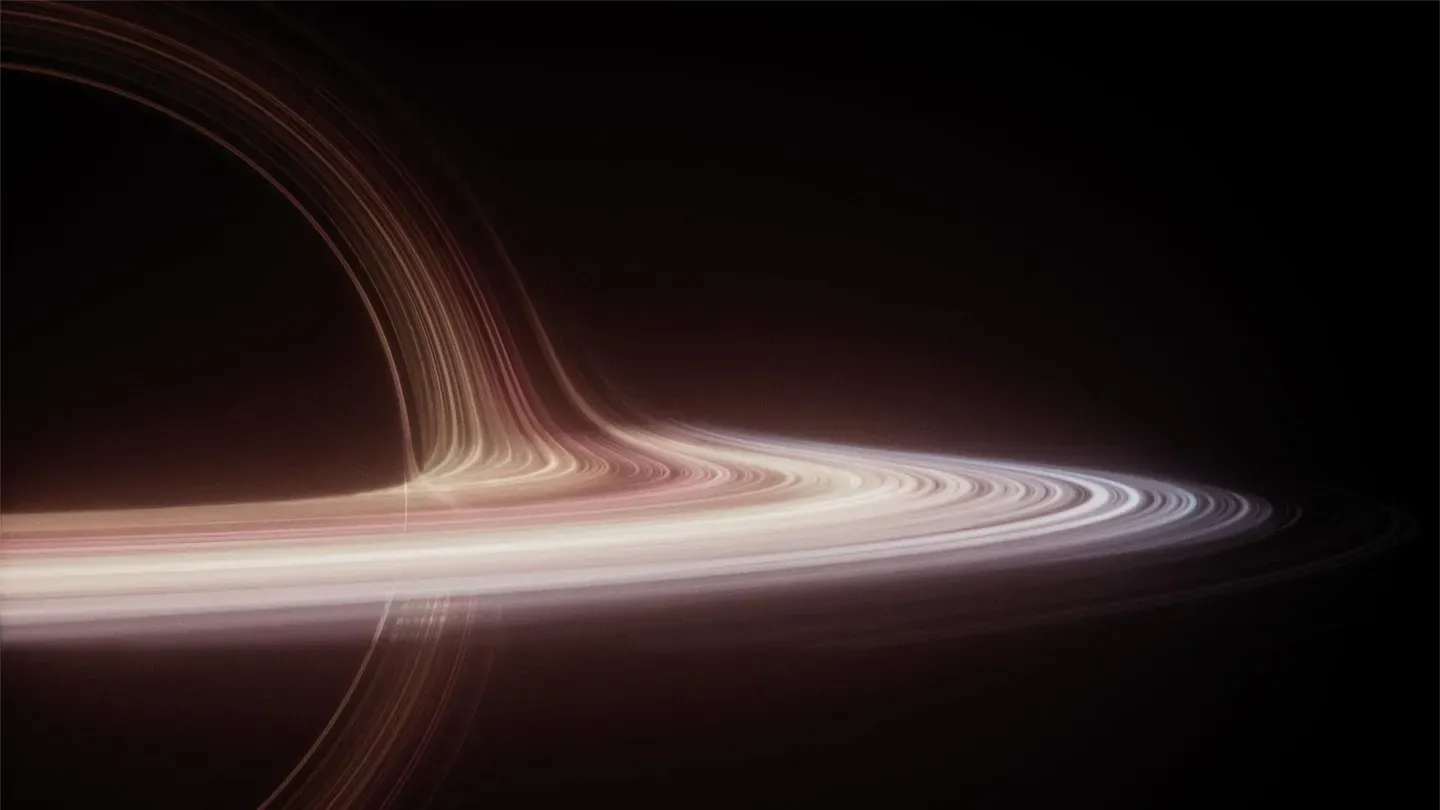

NOVA Universe Revealed: Black Holes
Season 48 Episode 18 | 53m 16sVideo has Audio Description, Closed Captions
Take a seat on the ultimate thrill ride as NOVA explores the universe’s strangest objects.
Take a seat on the ultimate thrill ride to explore nature’s strangest and most powerful objects. Discover new science showing how black holes reshape entire galaxies, warp the fabric of space and time, and might even be portals to another universe.
See all videos with Audio DescriptionADProblems with Closed Captions? Closed Captioning Feedback
Problems with Closed Captions? Closed Captioning Feedback
Additional funding for public engagement and outreach provided by the Gordon and Betty Moore Foundation. Funding for NOVA is provided by the David H. Koch Fund for Science, the Corporation...

NOVA Universe Revealed: Black Holes
Season 48 Episode 18 | 53m 16sVideo has Audio Description, Closed Captions
Take a seat on the ultimate thrill ride to explore nature’s strangest and most powerful objects. Discover new science showing how black holes reshape entire galaxies, warp the fabric of space and time, and might even be portals to another universe.
See all videos with Audio DescriptionADProblems with Closed Captions? Closed Captioning Feedback
How to Watch NOVA
NOVA is available to stream on pbs.org and the free PBS App, available on iPhone, Apple TV, Android TV, Android smartphones, Amazon Fire TV, Amazon Fire Tablet, Roku, Samsung Smart TV, and Vizio.
Buy Now

NOVA Labs
NOVA Labs is a free digital platform that engages teens and lifelong learners in games and interactives that foster authentic scientific exploration. Participants take part in real-world investigations by visualizing, analyzing, and playing with the same data that scientists use.Providing Support for PBS.org
Learn Moreabout PBS online sponsorship♪ ♪ NARRATOR: Something is hiding in the darkness.
Invisible objects of unimaginable power that could hold the key to solving the mysteries of space, time, and the universe itself.
To me, a black hole is the greatest exhibition of nature's mysterious powers.
SUGATA KAVIRAJ: You literally can't see them.
And that's what makes them extremely mysterious.
NARRATOR: They are bizarre quirks of nature.
BECKY SMETHURST: When we're studying black holes, we're right on the edge of human knowledge.
NARRATOR: And yet, they are sculptors of the cosmos.
IMOGEN WHITTAM: The jets from black holes are so powerful, they can affect the whole shape and nature of a galaxy.
NARRATOR: Even shaping our own galaxy, the Milky Way.
DELILAH GATES: We had hints that black holes were at the center of all of galaxies, like our own.
NARRATOR: Can we lift the veil... HAKEEM OLUSEYI: Forget the one-way trip to Mars.
I'm going in the black hole.
NARRATOR: ...and reveal their secrets?
Fermi revealed something completely astonishing and unexpected.
We've never seen anything like it.
Finding these little pieces of the puzzle that did not fit is super-exciting.
SHEPERD DOELEMAN: But if you really want to understand the deepest questions of the universe, you have to understand black holes.
♪ ♪ NARRATOR: "Black Holes," right now, on "NOVA."
♪ ♪ ANNOUNCER: Major funding for "NOVA" is provided by the following: ♪ See me when I float like a dove ♪ ♪ The skies above are lined with trees ♪ ♪ I'm on my knees, begging please ♪ ♪ Come and take me away ♪ ♪ ♪ NARRATOR: As we gaze out at the Milky Way, our eyes are drawn to the light.
Hundreds of billions of stars serenely spinning through the cosmos.
WHITTAM: When we look up at the night sky, the stars and planets that we see are beautiful.
But actually, it's in the space between these, in the dark patches, that some of the most fascinating things lie.
♪ ♪ NARRATOR: In places where there is no light, objects of profound mystery bide their time.
Awesome in their simplicity and perfection, we call them black holes.
KIRSTEN HALL: A black hole is an infinitely dense point in space from which nothing can escape, not even light.
It's extraordinary to think that black holes are everywhere in the universe, that they have existed from very early times in the universe.
NARRATOR: When quiet, they are almost impossible to detect.
URMILA CHADAYAMMURI: We're talking about a region of space where, if something falls in, we'll never know about it ever again.
♪ ♪ NARRATOR: They hold the power to shred stars and worlds, but also, the potential to shape galaxies... Black holes are one of the most fundamentally important singular objects that might dictate how galaxies form and evolve.
ANDREW PONTZEN: It's natural to fear them, but we're learning that they're essential.
You can't live with them, but you also can't live without them.
♪ ♪ NARRATOR: And they may hold the secret to the ultimate fate of the universe.
HALL: Black holes, on a fundamental level, challenge our understanding of physics, of the way that everything in the universe works.
Black holes are the most mysterious objects in the universe, full stop.
♪ ♪ NARRATOR: To understand black holes, we have to start at the beginning.
At the moment of birth.
CHIARA MINGARELLI: Black holes that are a few times the mass of the sun probably formed from giant stars that were maybe about 20 to 30 times the mass of the sun.
♪ ♪ NARRATOR: Enormous stars burning bright blue with intense heat.
But the brightest stars are the shortest-lived.
TREMBLAY: A star is a big ball of gas, right?
There's outward gravity pushing in, right?
The thing wants to collapse in on itself under its own self-gravity.
But the fusion that's happening within the star's core liberates so much light that the outward radiation pressure prevents the collapse of that star.
But eventually, that gives up.
NARRATOR: A star like that can burn through its nuclear fuel in just a few million years.
♪ ♪ And when its power source runs out, it collapses under its own gravitational pull.
There's so much material that's collapsing during their final few moments that they create this massive dense ball of neutrons that continues to collapse.
NARRATOR: A star 20 times the mass of our sun or larger... ...crushed by the force of gravity, until the star disappears, leaving only a ghost behind.
♪ ♪ A black hole.
♪ ♪ This transformation does not await all stars.
Smaller, less massive stars, like our sun, eventually become burnt-out dwarves when their fusion stops: slowly fading cinders.
But it's possible that almost all the massive stars that dominated the early universe formed black holes when they died.
Because black holes are simply what happens when enough matter is crushed into a small enough volume, dramatically warping the space around it.
DAVID ROSARIO: A river is a great analogy for the area right around a black hole.
Here I am far upstream, and the water is fairly placid.
It's not moving too fast.
If I were to get into the water here and swim across, I'd be able to do that very easily.
In the same way, if you're far away from a black hole, you'll be able to get around with just a normal spacecraft without too much trouble and simple propulsion.
♪ ♪ NARRATOR: But the closer you get to the black hole, the stranger things become.
The collapsed massive star crushes down so small and so dense, it ceases to have a physical surface at all, becoming an infinitely small point in space, exerting a profound effect on the space-time around it.
ROSARIO: As the water gets closer to the waterfall, the speed of the water increases.
If I were to jump into the water right here, the speed of the current would be so intense that I wouldn't be able to swim against it, and I would be gradually pulled closer to the edge of the waterfall till I reach a point of no return.
And that's the same around a black hole.
♪ ♪ NARRATOR: Just outside the black hole, the fabric of space itself actually stretches inward towards the center.
ROSARIO: Not even stars, planets, people, even light cannot escape the pull of a black hole.
It's like a waterfall in the fabric of the universe.
NARRATOR: The black hole's gravitational reach is not infinite.
CHADAYAMMURI: People have this idea that black holes suck, in the sense that they suck everything into them, but that's not true.
Black holes can only eat things that are within a certain distance away from them.
If you're further away, then the black hole has no way of eating you.
NARRATOR: But once in its grasp, you are lost forever.
And this is the key to their mystery.
The black hole's interior is hidden from view, cut off from the rest of the universe by a boundary in space: the event horizon.
Beyond this point, there is no escape.
♪ ♪ As we approach the event horizon, we get our first glimpse of the true weirdness of black holes.
ROSARIO: Ever since Einstein, we've viewed the fabric of the universe not as something static, but instead something that's fluid, something that bends and warps around objects with mass.
We call this space-time, a combination of space and time.
See, Einstein's insight was to realize that these two things are intimately connected.
That when an object has mass, it not just bends space, but changes the passage of time itself.
In particular, the effect of a mass is to slow time down.
NARRATOR: In the region around the black hole, the warped space-time elongates light waves, distorting color.
The event horizon is the place at which time stops when seen from far away.
Someone who's outside the black hole will see you get redder and redder... (speech slowing): And your time will slow down.
(normally): And you'll kind of pass through the horizon, disappear forever.
♪ ♪ ♪ ♪ NARRATOR: Black holes are like waterfalls in the fabric of the universe, where space contorts and time itself grinds to a halt, ensnaring light, making them lockboxes for the universe's ultimate secrets.
♪ ♪ STEPHEN HAWKING: It is said that fact is sometimes stranger than fiction, and nowhere is that more true than in the case of black holes.
Black holes are stranger than anything dreamed up by science fiction writers, but they are firmly matters of science fact.
NARRATOR: The vast majority of black holes are small-- less than 20 miles across-- and they usually wander alone through space.
But if we turn our gaze towards the center of the Milky Way and journey inwards, through the gas and dust that shroud the galactic core, signs of something altogether different appear.
TREMBLAY: If you simply observe the stars in the very heart of our galaxy over about 20 years, you will observe them orbiting nothing.
At the center of this swarm of stars is darkness.
It's a void.
NARRATOR: Scientists name this invisible enigma Sagittarius A-star, although it is not a star at all.
PONTZEN: Can you imagine how massive that object has to be to be able to pull entire stars into orbit?
NARRATOR: They believe it to be a black hole more than four million times the mass of our sun-- many thousands of times more massive than any other in the Milky Way.
KAVIRAJ: How did this monster come to live at the heart of the Milky Way?
NARRATOR: Sagittarius A-star is a supermassive giant around which the entire galaxy spins, raising intriguing new questions about the role of black holes in our galaxy and the universe.
How did it get there?
How did it get so big?
And what can it tell us about how black holes shape the cosmos?
SMETHURST: Would we even be here today without Sagittarius A-star?
WOMAN: Just a few minutes away from the 26th flight of the shuttle Columbia, with a crew of five.
♪ ♪ KIMBERLY ARCAND: I think a night launch is particularly exciting.
WOMAN: Go for engine start.
We have booster ignition and lift-off of Columbia.
MAN: Roger roll, Columbia, we're looking in.
CHADAYAMMURI: Chandra is huge.
It's about the size of a school bus.
It's the largest telescope to ever be launched by the space shuttle.
♪ ♪ MAN: SRB separation is confirmed.
You're stressed about the astronauts onboard that are literally risking their lives to help us get a better view of the universe.
NARRATOR: In the summer of 1999, NASA's flagship telescope for X-ray astronomy sets off from the space shuttle cargo bay.
♪ ♪ TREMBLAY: Even two decades into its voyage of discovery, Chandra remains by far the most powerful observatory that we have to observe the high-energy universe.
NARRATOR: Almost 83,000 miles above the Earth's surface, at its highest orbit, Chandra scans the sky with eight high-precision mirrors engineered to detect X-rays emitted from extremely hot regions of the universe.
For 14 years, it searches among the exploding stars and clusters of galaxies.
But then, on September 14, 2013, Chandra chances on something else entirely.
WHITTAM: Chandra wasn't looking for this at all-- just happened to be looking nearby.
So it was a total surprise.
♪ ♪ NARRATOR: As the telescope gazes into the constellation of Sagittarius, it aims to observe a large cloud of hot gas.
But unexpectedly, it records a flash of X-rays just a few pixels across coming from the seemingly empty space in the galactic core.
♪ ♪ KAVIRAJ: When we see something get very hot for a very short period of time, we get very excited.
Something is causing it-- something we can't see.
♪ ♪ NARRATOR: Some scientists believe the flash seen by Chandra is caused by an asteroid... ♪ ♪ ...ripped apart and burning up in a blaze hundreds of times brighter than the sun, releasing a burst of X-rays that Chandra can detect almost 26,000 light-years away.
If we see a level of X-rays being produced that's so bright, it can't be explained by any other process, then we know that there must be a black hole there.
NARRATOR: It's the behemoth at the center of our galaxy.
Sagittarius A-star.
♪ ♪ ARCAND: You can take a telescope like Chandra and watch a black hole have a small snack, maybe like a human might have a little biscuit in the afternoon.
And it's something like an asteroid.
And there will be a small sort of X-ray signature from that event.
KAVIRAJ: So it's incredible that we can actually observe Sagittarius A-star, which lies 26,000 light-years away, actually eating something.
NARRATOR: But Chandra does not only look inwards.
It also looks out, beyond the Milky Way.
At the center of almost every large galaxy Chandra peers into, it finds evidence that our galaxy is hardly unusual.
SMETHURST: We started to spot X-ray sources of light everywhere around the sky, and we started to realize something weird was going on in the centers of galaxies.
DOELEMAN: At the heart of most galaxies, we think now there are supermassive black holes, black holes that weigh millions or billions of times what our sun does.
CROSTON: It's incredible that our modern X-ray telescopes, like Chandra, allow us to map out where these fascinating black holes are across the universe.
♪ ♪ NARRATOR: Supermassive black holes seem to be an integral feature of the cosmos.
But these supermassive objects raise questions.
How do they form?
And why are they so big?
SMETHURST: These things form over millions to billions of years.
So we can't watch this happening.
We can only see it at various different stages throughout the universe.
And so we have to just piece it together like a jigsaw puzzle.
NARRATOR: Some scientists theorize that the biggest and oldest black holes did not start life as stars at all.
PRIYAMVADA NATARAJAN: In the very early universe, we believe that you could have formed very massive black hole seeds by direct collapse of gas.
So these black holes are called direct-collapse black holes.
NARRATOR: But the jury is still out.
HALL: It's possible that Sagittarius A-star formed by direct collapse of material.
What I think is more likely is that it formed by the death of a star.
NARRATOR: However Sagittarius A-star was born, one thing is certain: it had to grow.
♪ ♪ The newly formed Sagittarius A-star begins to feast, gorging itself on not just asteroids, but bigger game, like stars and massive clouds of gas.
WHITTAM: As it snacks on these nearby objects that wander into its path, it gets bigger and bigger and bigger.
NARRATOR: The black hole gains more mass and more gravitational power.
MINGARELLI: But black holes that are a few times the mass of the sun can never grow to be a supermassive black hole just by eating gas and stars.
NARRATOR: How did Sagittarius A-star speed up its growth?
On September 14, 2015, an international team of astronomers finds a clue, the aftershock of a truly titanic interaction: two colliding black holes.
TREMBLAY: So the merger of two black holes, as you might imagine, is spectacularly energetic.
It is so energetic that it causes ripples in the fabric of space-time itself that propagate outward at the speed of light.
And we have detected these ripples here on Earth with something we call LIGO.
HALL: LIGO is an instrument that works by sending laser beams that bounce off of mirrors.
When a gravitational wave passes by the Earth, this changes the timing of the interaction of those laser beams.
DELILAH GATES: The stretching caused by a merger here on Earth is absolutely minuscule.
But with advanced technology, LIGO was able to do it.
♪ ♪ NARRATOR: Many scientists now think that mergers like this are the key to how supermassive black holes, like our own, grow so big.
♪ ♪ When another black hole wanders towards Sagittarius A-star, they become locked in a gravitational embrace.
NATARAJAN: First, it is sort of an intriguing dance.
They kind of dance around each other, lose energy, and slowly spiral into each other.
♪ ♪ This dance gets faster and faster and faster and faster until they finally merge.
♪ ♪ NARRATOR: Sagittarius A-star cannibalizes its cousin... ...creating ripples in the fabric of the universe itself.
WHITTAM: These mergers were fundamental to making Sagittarius A-star the monster that we see today.
They happened billions of years ago, right at the beginning of Sagittarius A-star's life.
♪ ♪ NARRATOR: More meals follow.
Stars, gas clouds-- whatever strays too close.
And as our black hole's mass and influence grows, its surroundings are changing, too.
♪ ♪ The sea of stars and gas around the black hole continues to grow... ...gradually evolving into the familiar spiral disk we call home: the majestic Milky Way with the supermassive Sagittarius A-star at its core.
KAVIRAJ: So when Sagittarius A-star becomes a supermassive black hole, it really comes of age, and it acquires the ability to have a transformational impact on the evolution of the entire galaxy.
DOELEMAN: Black holes are the ultimate engines in the universe.
When you think about a car, the first thing you're interested in is, how does it work?
You open the hood and you look at the engine of the car.
With a black hole, you're asking, "I want to lift the hood up on an entire galaxy.
How does a galaxy power itself at its very heart?"
♪ ♪ NARRATOR: The center of the young galaxy is rich with swirling gas and dust: more offerings to feast on.
♪ ♪ This is a gluttonous period, a new era for Sagittarius A-star... ...when the invisible giant has the power to sculpt the galaxy.
♪ ♪ WHITTAM: As Sagittarius A-star is gorging on food, the food that it's waiting to eat is swirling around the central supermassive black hole in this violent, energetic disk, and the matter is ripped apart by the gravity, which causes the protons and electrons to then make these twisted magnetic field lines.
OLUSEYI: Everything is rotating and orbiting, so at the center of this black hole, this accretion disk, you have a twisted magnetic field, almost like a tornado.
ARCAND: Right before material approaches that event horizon-- that, that eternal prison, if you will-- it can be redirected instead.
NARRATOR: And from the blazing tumult, the super-heated material is thrown out along the magnetic poles... ...two high-powered jets launched out into the cosmos.
They can reach hundreds of thousands of light-years from the black hole itself.
NARRATOR: It's only recently that we've begun to grasp the huge influence of Sagittarius A-star on our galaxy and the role that those super-powered jets may have played.
MAN: Engines start.
One, zero, lift-off.
The Delta rocket carrying a gamma ray telescope searching for unseen physics in the stars of the galaxies.
♪ ♪ NARRATOR: Just over a decade ago, astronomers made a completely unexpected discovery.
It was this whole piece of our galaxy that we never knew was there before.
It would be like finding a brand-new continent on Earth.
NARRATOR: The Fermi space telescope was built to detect gamma rays, the most energetic radiation in the universe.
FINKBEINER: Fermi is roughly 100 times as sensitive as previous gamma ray telescopes.
So it has the sensitivity to see things that we just simply couldn't see before.
NARRATOR: Orbiting the Earth once every 96 minutes, Fermi constructs a map of the cosmos and uncovers an invisible landscape-- the most energetic regions of the galaxy highlighted across the sky.
ARCAND: So we pointed the Fermi telescope towards our very own supermassive black hole, and we had a picture of what that area sort of looked like-- in our minds, at least.
But then Fermi revealed something completely astonishing and unexpected.
NARRATOR: Emerging from the plane of the Milky Way are two enormous bubbles, each one stretching 25,000 light-years, together reaching half the width of the galaxy.
FINKBEINER: If you could see in gamma rays, the Fermi bubbles would be about the biggest thing you see on the sky.
They look like huge dumbbells going straight up and straight back from the center of the black hole.
NARRATOR: The bubbles match the imprint scientists expect an enormous eruption from Sagittarius A-star to leave on the galaxy.
CROSTON: We had had some clues that the Milky Way might have had a more energetic and active past, but the incredible thing about the Fermi bubbles was that they suddenly gave us concrete evidence that the Milky Way was much more energetic at some time in its history.
♪ ♪ NARRATOR: When our black hole gorges, it unleashes a towering inferno of super-heated matter.
TREMBLAY: A supermassive black hole can impart something like a trillion, trillion atomic bombs' per second worth of energy.
DOELEMAN: If we were to be in the line of fire of one of those jets, it would be catastrophic for us.
We'd be vaporized.
♪ ♪ NARRATOR: Every planet in the jet's path could have its atmosphere stripped away.
♪ ♪ But further out in the galaxy... ...these violent outbursts from Sagittarius A-star may have played a surprising role.
(birds chirping) Because the hot gas displaced by the supermassive black hole has a calming effect on the galaxy that hosts it.
HALL: In order for stars to form, you need very cold and very dense gas, because stars form through the collapse of material.
CHADAYAMMURI: So, instead, if you have something like a supermassive black hole that is sending out these hot jets into the galaxy around it, those jets are going to heat up the gas.
Now the gas is no longer cold enough to collapse and then form a star.
DOELEMAN: There's a symbiotic relationship between the supermassive black hole at the center and its host galaxy.
And this relationship determines the rate at which stars form, planets form, and ultimately, in some sense, why we are here.
♪ ♪ ♪ ♪ NARRATOR: After spending billions of years consuming the gas, dust, and stars around it, there is little left to feast on.
Our black hole falls dormant.
Today, the Milky Way has entered an era of calm and Sagittarius A-star is a sleeping giant, the enormous bubbles spotted by the Fermi telescope echoes of a lively past.
FINKBEINER: You never want to assume that you live at a special time in the history of the universe.
But it is kind of a special time that, right now, the black hole is very quiet, and it must have been much more active a few million years ago.
NARRATOR: As our understanding has grown, our picture of black holes has transformed, no longer sinister monsters, but agents of change and creation.
Sculptors of the cosmos.
ROSARIO: We are far from unlocking all the secrets of our galaxy's supermassive black hole.
And in fact, the stuff that remains is probably the most interesting: what happens inside a supermassive black hole and at its event horizon.
HAWKING: Black holes challenge the most basic principle about the predictability of the universe and the certainty of history.
♪ ♪ Nothing could get out of a black hole.
Or so it was thought.
NARRATOR: Black holes are where two of our greatest theories collide and clash.
DOELEMAN: So you've got these two primal forces in the universe: gravity, which we all understand and feel with our bones.
And then you've got quantum mechanics, which governs the theory of the ultra-small, how atoms and nuclei come together.
The black hole is where gravity and quantum mechanics finally meet.
SYLVESTER JAMES GATES, JR.: When we try to take the mathematics of the very large and try to combine that with the mathematics of the very small, instead of matching...
They get into a fight.
And so we don't have a consistent way to describe both.
NARRATOR: We can begin to probe this deep mystery by investigating the heart of Sagittarius A-star.
Scientists have studied dozens of stars in its orbit, some passing just a few billion miles from the event horizon, a hair's width on galactic scales.
And these fly-bys could have catastrophic consequences... ♪ ♪ ...because some of these stars likely have planets in orbit.
Planets that may stray too close.
Moths to a flame.
Pulled from their parent stars towards the abyss.
TREMBLAY: So imagine you're some alien civilization looking up at your lovely home star, S2, in the sky.
And one day, the thing starts wandering closer and closer to what we call the tidal disruption radius of Sagittarius A-star, this four-million-solar-mass black hole.
WHITTAM: If you fell into a black hole, you'd pass the event horizon, and actually, bizarrely, you'd see nothing.
There's no physical barrier, there's no big line in space saying "point of no return."
You would just drift very casually, gently across the event horizon.
NARRATOR: If we could stand on such a planet and look outwards, we'd see something spectacular.
♪ ♪ OLUSEYI: You would see a distorted universe, and in fact, you'd see it distorted in both time and space.
WHITTAM: You'd see it playing out at an amazingly fast speed.
The rest of time would play out unbelievably fast in front of your eyes.
♪ ♪ NARRATOR: But eventually, tidal and gravitational forces become too strong... ♪ ♪ ...stretching space and everything in it.
WHITTAM: Your feet would be pulled more strongly by gravity than your head, so you'd be stretched out into a giant string, and eventually, you'd be one long string one atom thick.
We call this spaghettification.
NARRATOR: Boulders become rocks.
Rocks become sand, whose very atoms are then pulled apart.
Gravity and the quantum world collide.
Ahead, the heart of the black hole-- the singularity, where all journeys in terminate.
OLUSEYI: Our idea of a singularity is that everything is compressed beyond what it can be until it's nothing, but yet still exists.
That is... (blows out): Wow.
♪ ♪ NARRATOR: Over trillions of years, all the stars around Sagittarius A-star will gradually fade out of existence.
♪ ♪ KAVIRAJ: Long after the last-ever sun sets on any planet, black holes will continue to roam the universe.
♪ ♪ NARRATOR: The final dark age.
TREMBLAY: If nothing can ever escape, if this is some eternal prison, is that the end of the story?
NARRATOR: Perhaps not.
Because scientists now believe that even Sagittarius A-star will die.
And its death will come at the hands of what might seem an inconsequential effect first described almost five decades ago.
CHRIS DONE: So in 1975, Stephen Hawking published this amazing paper showing that black holes aren't absolutely, completely black.
They glow very, very faintly.
They have a temperature associated with them.
And you can write that temperature very simply in an equation that's just beautiful.
It links together so many different parts of physics.
It's got gravity in it.
It's got the mass of the black hole in it.
It's got the speed of light.
It's got constants relating to atomic physics, the microworld.
And it's putting all of these together and giving us a temperature.
NARRATOR: Hawking's equation has huge implications for the future of the black hole.
So if something has a temperature, it's glowing, it's radiating.
Like when you put your hand close to a fire, you can feel it.
And that losing energy, for a black hole like Sagittarius A-star, over timescales that are hugely long, it's going to evaporate away.
It's going to disappear.
♪ ♪ NARRATOR: Very gradually, this Hawking radiation will erode away Sagittarius A-star until, many trillions and trillions of years into the future... ...in a final burst of light... ...our black hole will disappear.
And then the Milky Way will be completely dark for all eternity.
DONE: So why does it matter if these black holes disintegrate in the far distant future?
Well, the discovery of Hawking radiation raised some profound questions in physics.
If I was to set fire to this piece of paper with Stephen Hawking's equation written on it... ...what happens to all that information as it burns away, as it radiates away?
Do we lose it from the universe forever?
Maybe if I could sweep up all the ash, if I could find all the photons and reconstruct them, maybe I could reconstruct that piece of paper, even the equation written on it.
So does this also apply to black holes?
What happened to all the information contained on all the material that ever fell into a black hole?
And as a black hole evaporates, what happens to it?
HAWKING: Black holes ain't as black as they are painted.
They are not the eternal prisons they were once thought.
So if you feel you are in a black hole, don't give up.
There's a way out.
NARRATOR: If information somehow escapes from Sagittarius A-star as it evaporates away, the implication is profound.
Scientists now believe that every star, asteroid, planet-- everything that ever fell into Sagittarius A-star-- may live on, every aspect and position of every particle encoded as information.
All that you would theoretically need to put the whole back together.
So the memory of every single thing that's "fallen into," become part of, Sagittarius A-star in the Milky Way hasn't been lost.
It's still there.
It's just that we can't access that now.
But maybe we might be able to read the ashes of that memory in the far future of the universe.
NARRATOR: But how can anything escape a black hole's grip?
PONTZEN: The defining fact of a black hole is that nothing should be able to get out.
And yet when you look at Hawking radiation, it seems to be suggesting that quantum physics does connect up the inside back to the outside.
We just don't really know how.
NARRATOR: Black holes force us to consider nature in entirely new and mind-bending ways.
DELILAH GATES: People aren't at all certain about the resolution to what happens when we throw things into black holes, as far as where the information goes.
It's still an open question.
Maybe it gets sent to a portal to another dimension, maybe it gets pumped into some other branch of a larger multiverse.
Some people imagine that black holes are really just a kind of quantum fuzz, a fuzzball.
DOELEMAN: Some people think that all the information that fell into the black hole is somehow encoded on its surface in a hologram.
RICHARD ANANTUA: But we're not really privy to any of this information.
And if we want to find out, we'd have to go in.
NARRATOR: Whatever the solution proves to be, it will have ramifications far beyond the black hole itself.
♪ ♪ MINGARELLI: This theory of quantum gravity that's so elusive right now, that is what we would need to describe what's happening inside black holes, could either be the most exciting development to happen in the next decade or maybe even the next century, or it could be an alarm bell going off in our heads that maybe Einstein's theory of gravity is not the final word on gravity.
NARRATOR: Solving the mystery of black holes may be our best chance to complete the picture of nature that has eluded us for the last century.
KAVIRAJ: So perhaps the important thing isn't what the answer turns out to be.
The important thing is that we will gain a fuller understanding of the cosmos by studying these remarkable objects.
Studying the universe has completely changed our universe.
We have to rethink everything over and over again.
Like, it's almost, like, tear up the universe we know and write a new one.
NARRATOR: We're still a long way from fully comprehending the secrets of black holes, but we're beginning to lift the veil.
Far from being mere cosmic aberrations, black holes fundamentally shape our universe.
So it's extraordinary to think that we might be fundamentally connected to something that we didn't know existed for the vast span of human history.
♪ ♪ OLUSEYI: The beautiful thing about black holes is that they're such a rich source of information.
We've learned so much about the universe from studying black holes: space, time, the very fundamental nature of reality.
NARRATOR: Bit by bit revealing the deepest mysteries of the cosmos.
PONTZEN: We're in a golden age of discovery about black holes.
We understand how they merge, we've discovered their colossal jets, and we're beginning to see them not just as destroyers, but also as creators and sculptors.
And all that is just the beginning.
SMETHURST: Our story's happening now, but black holes, they're going to outlive us by trillions of years.
Their story is just getting started.
♪ ♪ ♪ ♪ ♪ ♪ ANNOUNCER: To order the five-part "NOVA: Universe Revealed" on DVD, visit ShopPBS or call 1-800-PLAY-PBS.
Also available with PBS Passport and on Amazon Prime Video.
♪ ♪ ♪ ♪
Take a Ride into a Supermassive Black Hole
Video has Closed Captions
Black holes distort the space-time fabric. (2m 41s)
NOVA Universe Revealed: Black Holes Preview
Video has Closed Captions
Take a seat on the ultimate thrill ride as NOVA explores the universe’s strangest objects. (30s)
Sagittarius A*: The Void at the Center of our Galaxy
Video has Closed Captions
Scientists believe a giant black hole sits at the center of our galaxy. (1m 54s)
Providing Support for PBS.org
Learn Moreabout PBS online sponsorshipAdditional funding for public engagement and outreach provided by the Gordon and Betty Moore Foundation. Funding for NOVA is provided by the David H. Koch Fund for Science, the Corporation...


